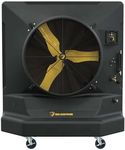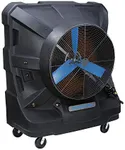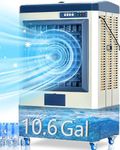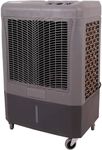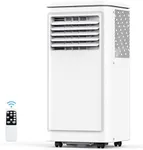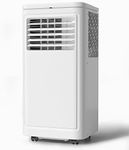Buying Guide for the Best Evaporative Coolers
Evaporative coolers, also known as swamp coolers, are a great way to cool your home or office in a cost-effective and environmentally friendly manner. They work by drawing warm air through water-saturated pads, which cools the air through evaporation before it is circulated into the space. When choosing an evaporative cooler, it's important to consider several key specifications to ensure you select the best model for your needs. Understanding these specs will help you make an informed decision and ensure you get the most out of your cooler.Cooling Capacity (CFM)Cooling capacity, measured in cubic feet per minute (CFM), indicates the volume of air the cooler can process and cool in one minute. This spec is crucial because it determines how effectively the cooler can lower the temperature in your space. For small rooms or personal use, a cooler with a lower CFM (up to 1,000) is sufficient. Medium-sized rooms or spaces may require a CFM between 1,000 and 3,000, while large areas or entire homes might need a CFM of 3,000 or higher. To pick the right one, consider the size of the area you want to cool and match it with the appropriate CFM rating.
Water Tank CapacityThe water tank capacity indicates how much water the cooler can hold, which directly affects how long it can run before needing a refill. This is important because a larger tank means less frequent refilling, which is more convenient for continuous use. Small tanks (up to 5 gallons) are suitable for personal or short-term use, medium tanks (5-10 gallons) are good for moderate use, and large tanks (over 10 gallons) are ideal for extended or heavy use. Choose a tank size based on how long you plan to run the cooler and how often you are willing to refill it.
Power ConsumptionPower consumption, measured in watts, indicates how much electricity the cooler uses. This is important for understanding the operational cost and energy efficiency of the unit. Lower wattage (up to 100 watts) is ideal for small, personal coolers, while medium wattage (100-300 watts) suits average-sized rooms. Higher wattage (over 300 watts) is necessary for large spaces or whole-house coolers. Consider your energy usage preferences and the size of the area you need to cool when selecting a cooler with the appropriate power consumption.
Noise LevelNoise level, measured in decibels (dB), indicates how loud the cooler will be during operation. This is important for maintaining a comfortable environment, especially in bedrooms or quiet spaces. Low noise levels (below 50 dB) are ideal for bedrooms or offices, moderate noise levels (50-70 dB) are acceptable for living rooms or kitchens, and higher noise levels (above 70 dB) might be suitable for outdoor or garage use. Choose a cooler with a noise level that matches the environment where it will be used to ensure comfort.
PortabilityPortability refers to how easy it is to move the cooler from one place to another. This is important if you plan to use the cooler in different rooms or locations. Portable coolers often come with wheels and handles for easy movement. Smaller, lightweight models are easier to move and are ideal for personal or occasional use, while larger models with sturdy wheels are better for frequent relocation or use in multiple areas. Consider how often you will need to move the cooler and choose a model that offers the right level of portability for your needs.
Additional FeaturesAdditional features can enhance the functionality and convenience of the cooler. These may include remote controls, timers, adjustable fan speeds, air filters, and oscillation functions. These features are important for customizing the cooling experience to your preferences. For example, a remote control allows you to adjust settings from a distance, while a timer can help you save energy by turning the cooler off automatically. Consider which features are most important to you and look for a model that includes them to improve your overall experience.

